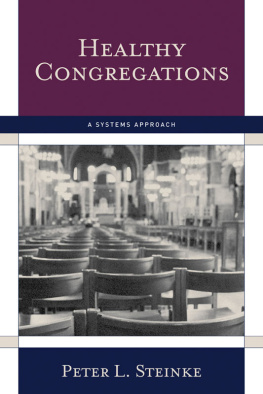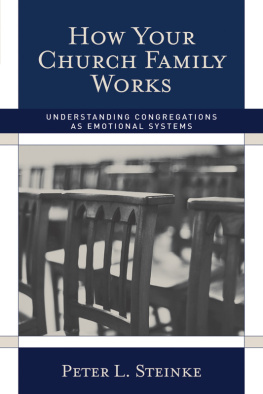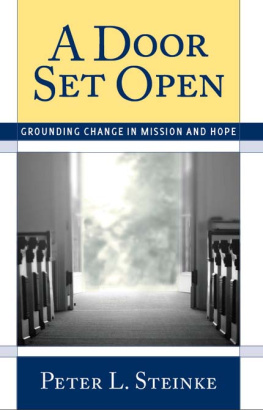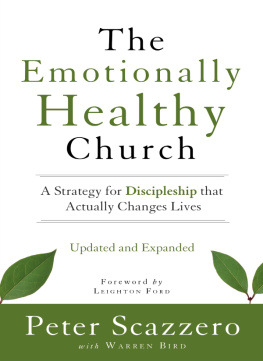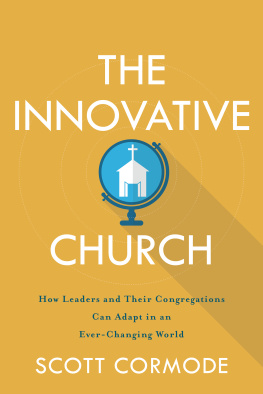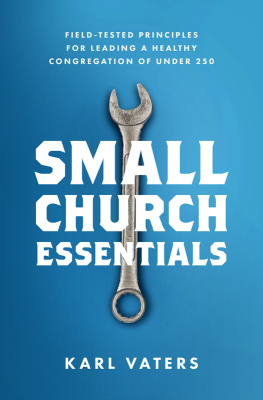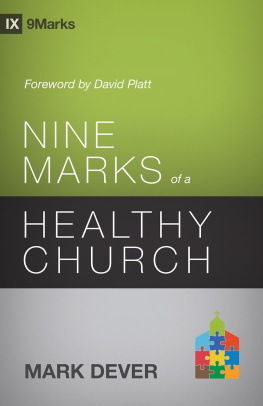Healthy Congregations
A Systems Approach
Peter L. Steinke
The Alban Institute
Herndon, Virginia
www.alban.org
Copyright 1996, 2006 by the Alban Institute, Inc. All rights reserved. For permission to reproduce, go to www.alban.org/permissions.asp or write to the address below.
The Alban Institute
2121 Cooperative Way, Suite 100
Herndon, VA 20171
Unless otherwise indicated, scripture quotations in this volume are from the New Revised Standard Version of the Bible, copyright 1989 by the Division of Christian Education of the National Council of the Churches of Christ in the United States of America. Used by permission. All rights reserved.
Scripture quotations marked KJV are from The Holy Bible, King James Version.
Scripture quotations marked NEB are from The New English Bible, copyright The Delegates of the Oxford University Press and The Syndics of the Cambridge University Press, 1961, 1970.
Scripture quotations marked RSV are from the Revised Standard Version of the Bible, copyright 1946, 1952, 1971, by the Division of Christian Education of the National Council of the Churches of Christ in the U.S.A. Used by permission.
The author also gratefully acknowledges permission to reprint the following:
Excerpt from Dakota. Copyright 1993 by Kathleen Norris. Reprinted by permission of Ticknor & Fields/Houghton Mifflin Co. All rights reserved.
Excerpt from In Pursuit of the Great White Rabbit. Reprinted with permission from In Pursuit of the Great White Rabbit by Edward Hays, copyright Forest of Peace Publishing, Inc., 251 Muncie Road, Leavenworth, KS 66048-4946.
Excerpt from The Way of the Sufi by Idries Shah. Copyright 1968 by Idries Shah. Used by permission of Dutton Signet, a division of Penguin Books USA Inc.
Cover design by Concept Foundry.
Library of Congress Cataloging-in-Publication Data
Steinke, Peter L.
Healthy congregations : a systems approach / Peter L. Steinke. -- [2nd ed.].
p. cm.
Includes bibliographical references.
ISBN-13: 978-1-56699-330-2
ISBN-10: 1-56699-330-X
1. Church controversies. 2. Parishes--Psychology. 3. System theory. I. Title.
BV652.9.S73 2006
250.11--dc22
2006036118
Contents
There are few, if any, pastors or counselors in the church who understand and communicate clearly what the Family Systems approach is better than Dr. Peter Steinke.
The author of the conflict resolution process called BridgeBuilders has now provided the preventative prescription for such situations in this writing which enables congregations to be proactive in maintaining a healthy attitude and atmosphere within the relational body they share together. The clarity of presentation, combined with superb illustrations and examples from other disciplines, especially medicine, as well as biblically based connections, allows the reader a way to grasp the essence of what healthy communities look like.
This book should be one of the resources used in church leadership retreats as well as in general adult education classes. Having a sense of how the interaction effects and affects the whole body can provide the necessary checks and balances within the congregational setting as it seeks to move forward in its mission and ministry. A healthy body does not happen by accident and having a prescriptive resource available, like this one, is an invaluable asset to life together and for the sake of the whole mission of the church.
Bishop Paul J. Blom
Texas-Louisiana Gulf Coast Synod (ELCA)
Soon after I had written Healthy Congregations, I was contacted by Lutheran Brotherhood in Minneapolis (now known as Thrivent Financial for Lutherans), a financial service company, concerning a partnership in developing assistance for congregations. I suggested elaborating on my new book and developing a series of workshops for lay leaders with the same nameHealthy Congregations. For nine years they financially supported the project, which led to the training of more than 1500 facilitators in 26 denominations. The Healthy Congregations effort is now located at Trinity Lutheran Seminary in Columbus, Ohio.
The interest in creating and sustaining healthy congregations is obviously widespread. Many leaders in churches have mentioned how helpful it is to have some standards or markers by which to gauge their congregations health. They realized, for instance, that as challenge to our physical bodies through exercise is health promoting, so challenge is to the body of Christ.
If I were to make any changes in the original manuscript today, I would place more emphasis on the key role of mood, tone, and spirit in enhancing congregational health, not unlike what weve learned about the relationship between attitude and social connections and our health. There are an increasing number of depressed congregations, ones that succumb to helplessness and hopelessness, especially as they continue to decline in membership, face a changing neighborhood, or stay stuck in monotonous or distressful patterns. They find it hard to maintain joy and vitality. Their dispirited mood limits their energy and imagination, the very resources they need to revitalize themselves. I wonder if the mood, tone, and spirit of a congregation isnt closely related to having a clear purpose, which in healthy congregations is a focus on mission. When life is meaningful, people have more energyand hope. The philosopher Fredrich Nietzche said that if Christians wanted others to believe in their Redeemer, they needed to look more redeemed.
This book is about the stewardship of the congregation: how people care for, respond to, and manage their life together. It is about holding in trust the well-being of the congregation. The health of a congregation involves the stewardship of the congregation as a unit in itself. In the introduction to Healthy People 2000, Dr. Louis W. Sullivan, former U.S. Secretary of Health and Human Services, declared, Personal responsibility, which is to say responsible and enlightened behavior by each and every individual, truly is the key to good health. Health is promoted by personal activity. Health comes from measures that each person can affect.
The same could be said for a larger organism, such as a congregation. Like healthy people, congregations promote their health through responsible and enlightened behavior. The people who are most in position to enhance the health of a congregation are precisely those who have been empowered to be responsible, namely the leaders. They are the chief stewards; they are the people who are willing to be accountable for the welfare of the congregation. They set a tone, invite collaboration, make decisions, map a direction, establish boundaries, encourage self-expression, restrain what threatens the integrity of the whole, and keep the congregations direction aligned with its purposes.
To address questions about the health of a congregation, we need to have in mind some picture of what health means. Health is wholeness. Health means all the parts are working together to maintain balance. Health means all the parts are interacting to function as a whole. Health is a continuous process, the ongoing interplay of multiple forces and conditions.
Health is not the absence of disease. Health and disease are not opposites. Physician Larry Dossey claims, The paradox, carved into our biology: life and health depend on illness and cannot exist without it. Disease disrupts the bodys balance. By doing so, disease provokes the healing capacities of the body to restore the very balance disease has disrupted. Many of the symptoms of disease are actually the bodys healing resources at work (for example, higher body temperature kills germs).
To talk about a healthy congregation is to talk about a congregation from an organic perspective. Only organisms can be said to be healthy or diseased. Only living systems are characterized by wellness or illness, soundness or injury, balance or disorder. In fact, the mark of organic life is the continuing play of balance and imbalance. When an organisms balance fails to some degree, or when the organism remains in a state of instability for too long a time, it is sick. When the whole process fails, the organism dies. Thus health is the capacity for life, what an organism must do to persevere. Health is the ability of a living system to respond to a wide assortment of challenges to its integrity.
Next page
